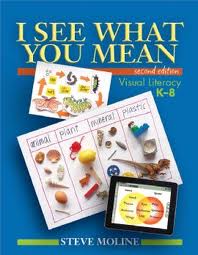21st Century Visual Literacy
I See What You Mean: Visual Literacy K-8 (2nd Edition)
By Steve Moline
(Stenhouse Publishers, 2012 – Learn more)
Reviewed by Patricia Thomas-Jeanig
Steve Moline has written a literacy book that all K-8 teachers, no matter what subject they teach, will find both informative and useful.
When the first edition of I See What You Mean: Visual Literacy K-8 appeared in 1995, the concept of information literacy was a new idea and visual literacy was even less-well recognized. Since then, the amount of digital information we read has increased tremendously and therefore our kids need to become digitally literate.
Most of what adults read and write today is in the form of information texts that include graphics, charts, graphs, tables, diagrams and maps. Smart phones, tablets, GPS and other personal devices have become part of our daily lives. Even more traditional information sources — books, TV, and newspapers — include more graphics than ever.
Because of these changes, Moline saw that the need for teaching visual literacy is vital. This new edition has been substantially revised and expanded to include new kinds of visual texts, more ways to use them, and it provides more examples to help teachers incorporate these skills in their teaching.
Don’t assume students understand what they see
I think that we can all agree that the ability to fully understand visual texts and be able to create them to share information with others is an essential part of being literate in the 21st century.

The chapters in this book are organized from the simple to the complex, and from the concrete to the abstract. The author has included a wide range of samples of student work to illustrate each type of visual text. One illustration shows a 2nd grader’s use of a simple diagram that is a picture glossary for the parts of a honeybee. Another shows how a 6th grader’s block diagram was used to record the measurements for the layers of the earth. A sociogram, another visual text, is a web that demonstrates the relationships between people in society: the sample given shows how votes, representatives, and the media influence opinion.
Moline also discusses bar graphs, column graphs, site maps, pie charts, structure diagrams, flow charts, timelines, storyboards, and many other manifestations of visual media. He includes suggestions for how each of these elements can be used in classrooms and offers some new ways of thinking about them.
Lots of good ideas
Diagrams can take the place of vocabulary lists or be used as summarizers of what a student has read. Instead of note-taking, students can record their research in a chart, a table or a graph. All of these elements can be applied to a multitude of subjects.
Some of these suggestions were familiar while others, like using diagrams to create problem-solving activities for students, were new to me (that one is such a great teaching idea!) Moline has thoughtfully included the web address for some of the figures used in the book, making them instantly ready for classroom use, and many are available in color.
Assessment guidelines are included in each chapter to help teachers define what to look for in student work. The chapter on Graphic Design also has some interesting ideas about teaching kids how layout, organization, typography and signposts to help readers understand more quickly the information being presented and therefore help students improve their own products by using these tools. Not sure what a signpost is?
An excellent resource and teaching guide
I See What You Mean is a great book, packed with useful information that every teacher will find interesting — and it may very well cause them to look at reading and writing in a different way. An extensive resource section lists books, apps, and websites for further investigation. The suggested activities and examples will immediately get teachers thinking of ways to incorporate them into their units and lesson plans, creating new ways for students to communicate information. And maybe like me, you are tired of seeing so many “cut and paste” research reports and are looking for some new strategies yourself to improve the visual literacy of your own work.
Whether you teach beginning readers, struggling readers, or ELL students, teaching kids how to be visually literate and to use visual tools to express themselves allows all of our students the opportunity to become excellent communicators and to better prepare themselves for living in a highly visual world.
Pat Thomas-Jeanig has worked with adult learners preparing for their GED as well as ESL students and low-income teens, helping them to enter the workforce. A long-time library lover and avid reader, she worked in public libraries before becoming a school librarian in Massachusetts.



































Fantastic background information – prompts teachers to use a wider set of tools for teaching literacy . My low level readers are enjoying high level discussions as they critically examine text and images from their world. It empowers me to plan and use tools that leave my students on equal footing with their peers. These students are changing. They realise that they are able to learn from other sources.